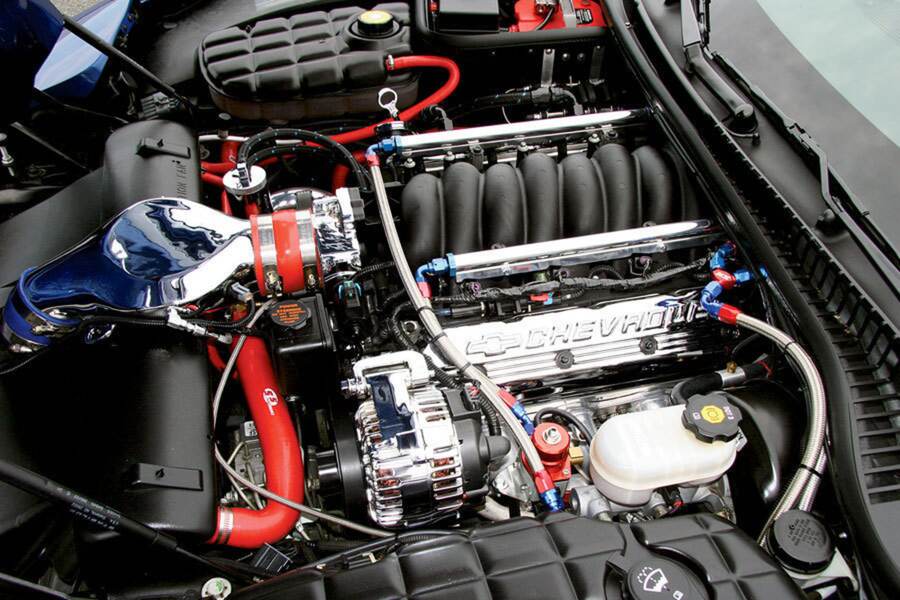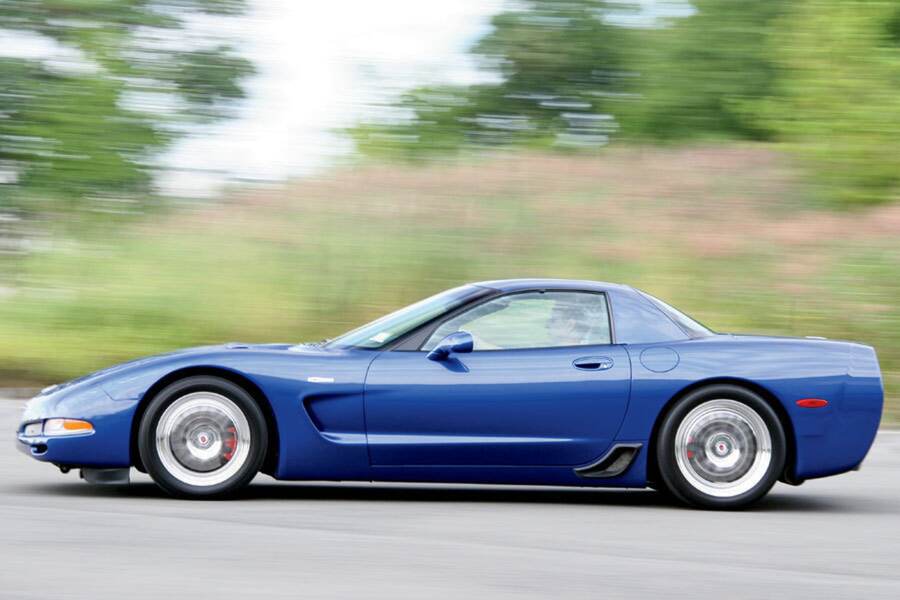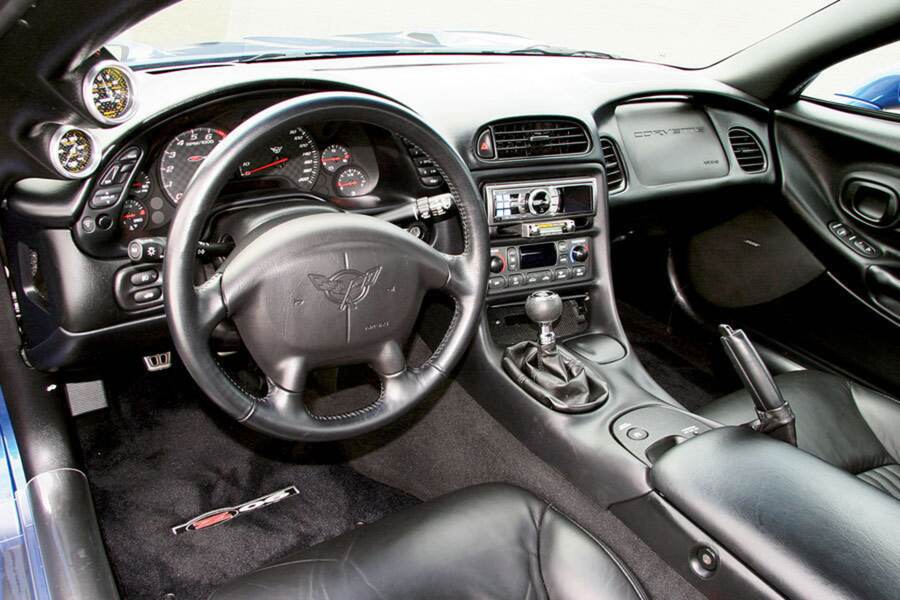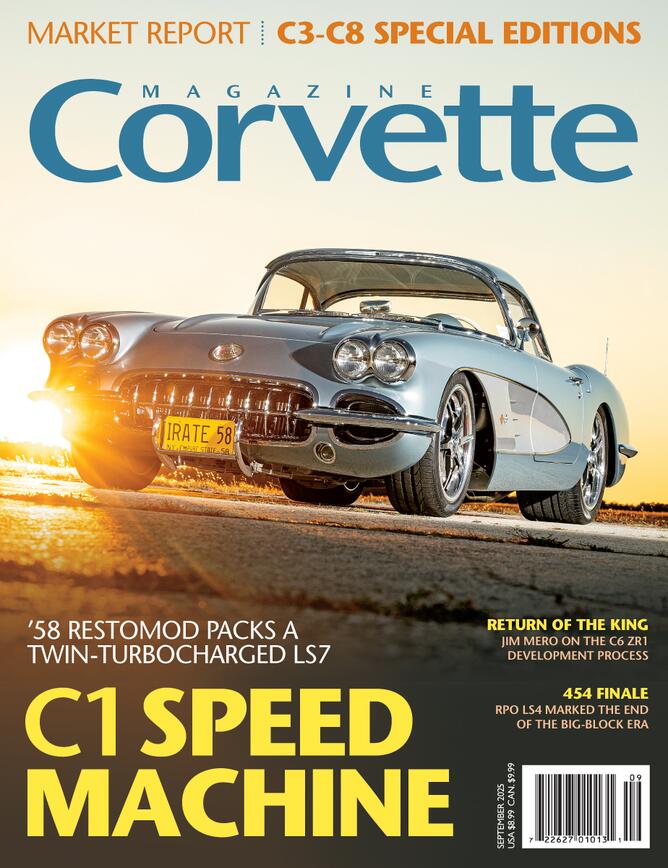Most Corvette owners experience multiple examples of the brand before taking on an engine-apart, mega-horsepower custom project. Not so for Ridgewood, New Jerseyite Jay Schron. Schron’s Electron Blue C5 is not only his fist Corvette, it’s also the first car he’s built that makes 800+ horsepower at the drive wheels.
Not surprisingly, while this is his first foray into Corvettes, it’s hardly his first enthusiast-car or tuning experience. “I’ve been a motorhead since I was 13,” Jay relates. “I had a ’68 Hemi Roadrunner back in high school, followed by a ’69 DZ302 Z28 Camaro and a ’67 GTO Tri-Power….”
Like many car nuts, Jay edged away from the scene after starting a family. His own daughter, as it turned out, got him back in decades later. Shortly after receiving her license, Jay’s 17-year-old daughter smashed up her late-model Celica. “To her credit, at the time we didn’t know she suffered from astigmatism; we just affectionately called her ‘Captain Crash Jr.’” Sure enough, once Schron the Younger got glasses she stopped running into things, but not before Jay had reclaimed her Toyota and started to study its engine. Soon he was actively hotrodding it, and his new hobby evolved into a partnership with a local import-tuning shop. Jay contributed business acumen to the facility by day; at night, his tuning pals pushed the Celica’s horsepower ever higher. Soon the car was a highly boosted turbocharged rocket and the shop was on track to sell hundreds of aftermarket forced-induction conversions per year.

Schron was now deep in the import-tuner scene, but he still felt the need for more power. Naturally, he gravitated toward Corvettes. “I was turning 50, the Corvette was celebrating its 50th anniversary, and the price was around $50K.” Everything seemed in alignment, so he purchased a brand-new Z06. Six months later, he was ready to give it more power.
“We were a jobber for Lingenfelter Performance Engineering, so I called up Ed Potter at LPE. I bought one of their modified Magna Chargers, some B&B long-tube headers, and sent them the PCM to be re-flashed with LS1 Edit software.” Schron also installed adjustable front and rear antiroll bars and new polyurethane bushings.
Six months later, the speed jones returned: While effective, the single-Magna Charger setup was no longer proving enough.

Next, Schron turned to Chris Corriel and Doug Ring at East Coast Supercharging, of Cream Ridge NJ. Chris still remembers their first discussion: “He came to us with a Maggy on his Corvette and we started talking cams and pulleys.” Nobody appeared to be making an undersized pulley for these units at the time, so East Coast machined the existing pulley to reduce its diameter, thus increasing blower speed and boost. An upgraded cam was installed as well, along with new PCM programming. The mods gave Schron six psi of boost, raising the modified car to above 500 rear-wheel horses.
“I drove it for a couple of months like that and said, ‘Nah, this still isn’t it for me.’” Given that sentiment, about all that was left was the higher potential top end promised by turbocharging. Schron decided to toss out the blower completely and start over.
From his time in the import scene Jay already knew LPE and other big names offered complete twin-turbo packages for LS1s and LS6s. He wanted to avoid shipping his car to a third-party tuner, however, preferring to remain fully involved in the design and conversion himself. His search for capable suppliers ended at Turbo Technologies Inc. in Tacoma WA. After some in-depth discussions, a TTI Stage X kit with bespoke long-branch cast-iron manifolds and dual TTI compressors was on its way to East Coast Supercharging.

When the pieces arrived, the staff reported back that the turbos looked to be on the smallish side—an observation that brought Schron into the garage on the double. After an inspection, “These are Turbonetics T3/T4 hybrids,” Schron told the ECS techs. “I’ve put a lot of these in. The performance has everything to do with the compressor wheel, and these are going to make a lot of power.”
Schron and ECS had no interest in a simple bolt-on installation; instead, the team was determined to fortify the entire LS6 package to accept massive infusions of boost—a goal that meant disassembling, strengthening, testing, balancing, and rebuilding the internals down the last nut and bolt. Nor could they resist making breathing tweaks while they were at it, leading to new Airflow Research heads.

Directly below these would be new pistons shaped to give 9.4:1 compression, a custom-ground Cam Motion shaft, Callies forged rods, and a Callies forged stroker crank, bumping total displacement to 382 cubic inches. According to Schron’s estimates all the new parts could withstand 25 pounds of boost—considerably more than his game plan called for. ECS upgraded the fuel system in kind, adding in-house-built rails, Motron 60-psi injectors, a Racetronics tank pump, and an auxiliary Bosch 420 external fuel pump. The fuel lines were sent through the tranny tunnel initially, but when turbo heating led to fuel vaporization they got re-routed through the driver-side rocker. To keep intake temperatures down, ECS also built an alcohol-injection system feeding the air-intake bridge from a hand-fabricated tank in the trunk. “There’s a rheostat inside the car,” Jay explains, “that I use that to adjust how much methanol enters the intake. We did alcohol injection for two reasons: To reduce the internal temperatures in the combustion chambers, and also as supplemental fuel. The computer reads the temperature going in and adjusts the timing and fuel-delivery mapping to match. Turbochargers essentially pump hot gas right into the motor; an alcohol sprays cools everything back down.” In addition to the manual switch, the system is triggered automatically by a MAP sensor at three pounds of boost. Assuming he’s not too busy avoiding slower cars by that point, the driver can keep tabs on this underhood action via Auto Meter boost and fuel-pressure gauges, a wideband oxygen sensor, and an air/fuel-ratio monitor.
A handful of driveline upgrades were required to turn all this potential performance into predictable forward motion. A Textralia OZ700 clutch now handles power flow to the transmission, which in turns has been fit with a DTE brace and Hurst shifter. Downstream, one finds the requisite hardened halfshafts.
All told, the conversion laid the car up at ECS for the better part of three months. Doug Ring, the ECS principle who did most of the physical installation, recalls some of the challenges he faced on this job. “The most tedious thing with a turbo system is properly heat-proofing all the wiring and lines; you’re talking about individually treating every wire. I’d work for a week on this project, and from the outside it didn’t look like I’d accomplished anything! Thankfully, Jay knows what it takes to do these projects right. He allowed us to do a proper job and build a proper product. It was a win-win for everyone.”

ECS rewrote the engine codes one more time, this time via EFI Live. After that the car was strapped to the ECS dyno for testing and final tuning. “I felt we’d see something above 700 horsepower,” Schron recalls. That number came up immediately, even at a conservative 12 psi. Additional software tweaks and a slow push to 15 psi resulted in 834 rear-wheel horsepower and an impressively flat torque curve that peaked at 822 lbs-ft.
From the outside, this Electron Blue Z06 certainly doesn’t scream, “Look at me—I’ve got more power than four Cessnas.” In fact the vented Haltech Stinger hood, front-plate intake, and flush-mounted taillights are the only changes Jay made to the body. HRE billet wheels—measuring 17×9.5 and 18×11 inside Toyo Proxes RA1s—hide crossdrilled Baer rotors clamped by Z06 calipers, but for the most part the chassis stayed stock.

Schron dismissed going hog-wild with interior mods as well. (“The stock C5 interior is crappy, frankly, but I decided to leave it alone,” he says.) Instead, he funnelled additional cash into a super-high-end stereo system. “As an audio aficionado, I was never really satisfied with the stock Bose setup.” The Corvette went to Cartronics in Glen Rock NJ for installation of components hand-picked by Jay: an Alpine IDA X001 head unit, XM receiver, six-CD changer, Focal Utopia 165W speakers, Stinger interconnects, and JL Stealth subwoofer, all driven by Zapco Competition amps. Cartronics also hardwired in a K40 radar/laser-detector unit and a Blitz R-Spec turbo controller.
After all that work, one question remains: What makes a guy build a traction-limited, insurance-endangering, 830+ bhp street car in the first place? “It just sort of happened,” Jay smiles. “When you add the right pieces, address all of the internal stress issues, and make very few compromises, the horsepower just keeps coming up.” While there’s clearly more power still to be found in the engine, he adds, there’s little point trying to get it. “It’s unusable beyond a certain point. With an independent rear suspension, you just can’t put the power down to the ground.”
Sure enough, even when track-prepped (which means skinny front tires and 26-inch M/T rear slicks) and given conservative 1500-rpm launches, traction is the car’s limiting factor. At 15 psi it’s “nearly undrivable” beyond the 660-foot mark, Schron reports; reducing the boost to 12 psi makes the run more controllable, with Schron seeing sub-10.4 quarters at nearly 140 mph. The team knows that faster times would result from more aggressive rear-drive hardware and race-style launches, but Jay is “…not interested in snapping the torque tube or getting into the whole money-pit of drag racing. I’ve done that before.”

In Jay’s eyes, the car is already enough of a handful. “Since the motor is stroked, there’s so much torque down low that it body-slams you into the seat and pins you there until you come out of boost. It’s like a rocket. The active handling gets overwhelmed pretty quickly, too, because the computer can no longer cut back on the power, which is the way that I wanted it. It’s a great toy—you just have to be very cognizant of what you’re doing. It’s easy to go from 55 to 130 on the turnpike if you’re not paying attention. You can’t be crazy with it.”
Amazingly, in the two years since East Coast Supercharging and Schron finished the car, everything has kept working flawlessly. That reliability, Jay feels, is a testament to the thoroughness of their concept and execution.
“I’m confident I could hop in it and drive straight to California without any problems, and on the highway in sixth gear I’d get 32 mpg!” His only plans for further mods are to add an extra oil cooler and a custom three-inch exhaust setup. Neither item is necessary, he realizes, but this project passed the point of diminishing returns years ago. Since his first and only Corvette won’t be up for sale anytime soon, all that matters is making it the very best it can be.





